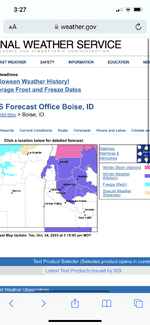Just remember, old deer are not evenly distributed everywhere - it’s like trout fishing a stream - there are large areas that don’t hold fish, and pockets that have a much higher probability. Just like trout fishing, just because you aren’t seeing them in likely looking pockets doesn’t mean they aren’t there. If you bump a fish it moves behind a different rock, snuggles in deeper where it’s at, or runs and hides in a ripple - don’t hunt deer where other people have bumped them, but look to the spots they go to get away - often not that far away.
If theres a lot of elevation gain in your area old deer became old deer because they have chosen seldom used sections and are holding tight much more than young bucks and does during the day. In the area I like to hunt I’ve never seen an old deer less than 2,000’ above the trailhead. Many old deer are taken at lower elevations, just not in this drainage - fantastic classic deer beds are just up the hill. Hunters look at maps and think 5 miles is a long way and a ridge looks so steep it’s not worth checking out, so they hunt the crappiest parts. Deer don't break a sweat walking 5 miles or working up a few thousand feet.
If you can’t get to the best deer beds up high, hunt an area without as much elevation where the best bedding areas will be close enough you can get to them. Maybe deer are bedding in brushy draws, maybe brushy hillsides. If you were an old deer and knew every inch of that area where would you hang out and why?
I used to drive by a ridge not 1/2 mile from a blacktop highway. It was maybe 500’ higher than the road, but there were no hiking trails to it, no game trails crossed the road, no easy places to park, no reason to go there, and never a sign of any kind of deer, at least from the road. However, it was the best structure in the area, and it held one of the oldest deer I’ve ever seen, well past his prime.
We crossed paths with a giant non typical crossing a road in the foothills. All sorts of people had seen him and they hunted hard for this one. I didnt go where he had been seen, because the ideal bedding areas were a couple of miles or more to either side of the road - he was just passing through and there was no way he was living near the spot he crossed.
When bedded deer see hunters they flee, try to carefully sneak off, or lay their head down flat like a dog and wait it out. Don’t rush by an area because the deer aren’t easy to see. My hunting buddy loves to take afternoon naps, and he’ll do it within rifle range of a brushy hillside - more than once a bedded deer waited almost a half hour then stood up and tried to sneak off.
Some guys want to see large numbers of deer, I don’t. I’m always looking for the shy loner and he may or may not have another buck with him, but they are not hanging around large numbers of young cannon fodder that will be taken out of the gene pool once combat hunting begins. They are in rougher, thicker areas and are less likely to run than young deer, so just because some young deer jumped up and ran off doesn’t mean they are the only deer.
I felt skunked one year - we hunted a wide open area with shallow draws that didn’t seem to be capable of holding anything - we hunted it for an entire week. Where we were was the best cover for bedding for 10 miles in any direction. Nothing. Backtracking an area we crossed and glassed twice before, not expecting to see anything alive, was a big buck. He had been there the whole time laying low all day in a shallow draw watching us looking for him.
Others are much better at knowing where deer hang out in areas without a lot of structure, but that’s what works for me.
edit: Not to beat a dead horse, but if you’re trying to understand an area go look for deer beds. If some country looks good, glass it a couple of times then go walk it - look to see if the bedding areas that looked good to you actually had evidence of deer use sometime this year. If not, you’re way off, but keep looking and eventually you’ll develop better radar and that will allow you to justify glassing longer in some spots and less in others.

